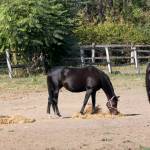Managing Equine Metabolic Syndrome: New Guidelines

The European College of Equine Internal Medicine recently recruited the world’s top veterinary endocrinologists to combine their knowledge of equine metabolic syndrome (EMS). Because of these efforts, the equine industry now has a guidebook for diagnosing and managing EMS*, a disorder in horses that frequently results in chronic, life-threatening laminitis.
After reviewing the risk factors for EMS, such as obesity and its underlying causes (primarily insulin dysregulation), the experts detailed the available tests for EMS and emphasized the need for treatment once diagnosed.
“EMS is controlled mainly by dietary strategies and exercise programs that aim to improve insulin regulation and decrease obesity when present. In some cases, pharmacologic aids might be useful. Management of EMS relies on long-term strategy, requiring diligence and discipline by the horse’s caregivers, and support and guidance from their veterinarians,” wrote the panel members in their statement.
“In terms of management, the panel made very clear recommendations,” relayed Kathleen Crandell, Ph.D., a nutritionist for Kentucky Equine Research.
Because many horses with EMS suffer from obesity, dietary management focuses on weight loss. According to the expert panel:
- Obese horses should lose between 0.5 and 1.0% of their body mass per week;
- Weight loss can be achieved by offering a forage-based ration totaling 1.4-1.7% body weight daily. If a horse weighs 1,000 lb (450 kg), then it would be offered 14-17 lb (6.4-7.7 kg) of appropriate forage (see below) daily;
- Offer forage containing <10% nonstructural carbohydrates to limit increases in insulin. Forage analysis and hay-soaking may be required to achieve this goal; and
- If a horse or pony appears to have “weight-loss resistance,” then it can be offered as little as 1.15% body weight in forage.
The panel also noted that many horses may require a ration balancer to ensure the horse receives necessary vitamins and minerals.
Crandell added, “Kentucky Equine Research offers Micro-Max, a low-intake, concentrated source of vitamins and minerals for mature horses, particularly those on diets composed entirely of forage or forage and small amounts of concentrate.” Australian horse owners have other research-proven options available, including Gold Pellet, Nutrequin, and Perform.
“The panel also advised owners to not offer grains or cereal-based complementary feeds, fruits, or vegetables, such as carrots, apples, or other treats, as well as high-fat feeds to obese horses,” said Crandell.
Exercise also plays an important role in weight management, but the exact program will vary from horse to horse and will depend on soundness.
“Consult with a Kentucky Equine Research nutrition advisor for an optimal diet and weight-loss plan, information on forage analysis, hay-soaking strategies, and nutritional supplements that may benefit your EMS horse,” advised Crandell.
*Durham, A.E., N. Frank, C.M. McGowan, et al. ECEIM consensus statement on equine metabolic syndrome. Journal of Veterinary Internal Medicine. In press.








